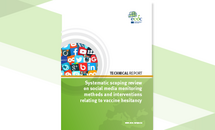Systematic scoping review on social media monitoring methods and interventions relating to vaccine hesitancy
Understanding vaccine hesitancy and social media: which social media platforms do users preferably choose as source of information on vaccination and how does that influence their perceptions of vaccination? A systematic scoping review by ECDC and the Vaccine Confidence Project summarises knowledge and research on social media and vaccination.
Executive Summary
Social media, understood as a means of communication as well as a space to socialise and interact, has become a common source for people to look for health information. Rather than consulting a single, authoritative source, they usually want a variety of opinions. At the same time, people are often exposed to information about vaccination online without necessarily looking for it.
The associated amplification of risk and risk perception through social media, has led some countries and health authorities to start monitoring social media platforms in order to counter the spread of misinformation and rebuild public trust in vaccination.
The purpose of this systematic scoping review was to analyse the social media monitoring techniques and interventions with the following objectives:
- identify preferences: which social media platforms do users choose as a source of information on vaccination and how does that influence their perceptions of vaccination?
- identify different methods and tools for social media monitoring in the context of vaccination including their strengths and weaknesses.
- review how such monitoring and information gathered from social media monitoring can be used to inform communication strategies around immunisation.
- identify the uses, benefits and limitations of social media as an intervention tool in relation to vaccination (i.e. how effective social media is as an intervention tool for increasing vaccination).
An extensive database search led to the inclusion of 115 scientific articles in the review, looking at the use of social media, social media monitoring and (public health) interventions.
The review results show for example that between 4 and 62% of various study populations in different countries use social media as a source of information on vaccination, with results varying by type of social media platform. Overall, Facebook was the most common social media resource for information on vaccination.
Some key findings from the review:
Social media monitoring:
- Social media monitoring is a new area of research methodology, which can help national health authorities understand how information about vaccination is shared and spread online.
- Social media monitoring should take into account important ethical considerations in terms of access to public and private data, the use of human research subjects, and confidentiality and anonymity (particularly for vulnerable populations).
- At present, there are no standardised methods for monitoring and analysing social media in relation to vaccination, and more tools need to be evaluated.
Preferences for using different social media platforms:
- The types of social media platforms and their use vary by country and by population group (e.g. pregnant women’s consumption of vaccine information on social media was found to be different from the general population).
- There is a need to have an understanding of who may influence decision making (family members for example often have the strongest influence on decisions regarding vaccination).
- Social media interventions to address vaccine hesitancy should focus on specific populations. Public health authorities should first seek to understand what platforms their local populations use (e.g. parents, versus adolescents, versus pregnant women), as well as the local context in which people use social media, before developing social media communication strategies.
Use of social media monitoring for communication:
- Continuous monitoring can be used to investigate how public concerns as well as questions about vaccines have tended to change over time, enabling health authorities to develop tailored, targeted, cost-effective and responsive public engagement.
- Consistent, long-term proactive communication activity may be more beneficial than reactive or event-driven public health communication, a finding that may be useful for planning policy around public health interventions to increase vaccine confidence.
Social media interventions:
- Although no social media intervention was found to significantly increase vaccine uptake, it may be difficult to accurately link an individual’s vaccination status to a specific component of an intervention. This is particularly true as social media are only the channel for communication and other factors, such as the content or style of messages (outlining the benefits of vaccination and downsides of not vaccinating via loss-framed vs gain-framed messages, narratives vs. scientific facts) also influence beliefs and behaviour.
- Social media interventions were found to positively influence attitudes related to vaccination, including knowledge, perceived barriers and risk perceptions.
Social media monitoring has public health implications. It can be used to: detect increases in online activity, shifts in sentiments or other signals of decreasing confidence in vaccination; as a tool for health authorities to increase their presence and popularity on social media; and finally as a real-time listening tool to anticipate, understand and respond to public questions and concerns.
In general, it is crucial that health authorities and immunisation managers start incorporating social media monitoring as part of their traditional vaccination surveillance strategies – and not only after a confidence crisis occurs.







